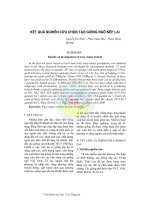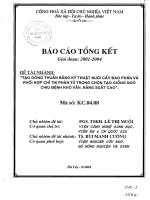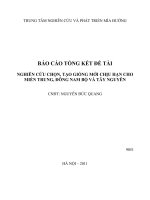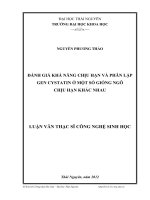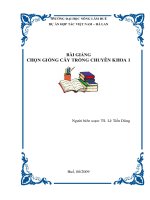BAI GIANG TAO GIONG NGO CHIU HAN docx
Bạn đang xem bản rút gọn của tài liệu. Xem và tải ngay bản đầy đủ của tài liệu tại đây (1.06 MB, 54 trang )
DROUGHT TOLERANCE
IN MAIZE -THEORY & PRACTICE
Pervez H. Zaidi
Physiologist (VS),
Maize Program, CIMMYT
GLOBAL CLIMATE CHANGE &
PROBLEM OF DROUGHT
Increased crop water requirement & use
Accelerated rates of crop growth & development
Reduced rate of transpiration & increased photosynthesis
More heat stress
Less stable weather
Major shift in weather pattern
Impact on maize:
Frequent exposure to drought stress
Both win & loss situation, but unpredictable
Increase in yield in highlands
About 9-10% decline in yield in tropic
More severe decline (17%) in production in sub-Saharan Africa
CHARACTERIZATION OF
DROUGHT ENVIRONMENT
Complex & far more difficult, because:
Global phenomenon with wide variability in degree, rather than kind
Tend to be distributed in a patchwork fashion round the world
Variation in intensity, severity & duration year-to-year and location-to-
location
Nevertheless, it is crucial for making decision & research planning
Essential data sets:
Joint probability distribution index of water deficit in maize crop
at different crop stages
Long-term data on weather pattern (rainfall, humidity,
temperature, sunshine hours etc)
Detailed data on soil properties
Measure of the effects of water deficit on crop yield
Geographic distribution of maize planted by farmers
APPROACHES TO DEFINE
INCIDENCE & INTENSITY OF DROUGHT
Approaches Reliability Reprodu
-cibility
Degree of
quantification
Cost
1. Expert opinion
2. Cluster analysis of
monthly weather data
3. Cluster analysis +
expert opinion
4. Cluster analysis of crop
simulation results
5. Crop simulation results
+ expert opinion
**
**
***
****
*****
*
***
**
***
**
*
**
***
*****
****
**
**
***
****
*****
Source : White & Elings (1997)
DEFNITION OF DROUGHT
FOR MAIZE CROP
Based on rainfall: (Chapman & Baretto, 1996)
<500mm rainfall in lowland tropic and subtropical regions; <300-350mm
in highlands - unsuitable area
<100mm rainfall received during four weeks bracketing flowering;
unsuitable for maize crop - unsuitable area
100-200mm around flowering - marginal area
>500mm total rainfall & >200mm around flowering - suitable area
Based on ratio of precipitation to evapotranspiration (P/PE)
P/PE >0.5 for during n (crop season) or more months - suitable area
P/PE >0.5 for n-1 or less months - marginal area
P/PE <0.5 during n-1 or more months – unsuitable area
WATER RELATIONS
Solvent, cooling agent, reagent, maintenance of cell
structure (cell turgor)
Water potential (ψ):
* Measure of pressure needed for water extraction, unit- MPa (=10 bar).
* Usually negative, indicating the status of water compared to full
saturation
* Water movement – from higher to lower WP i.e from less to more
negative, e.g Soil (-0.35 MPa) –Plant (-4.5 MPa) -Atmosphere (-80
MPa), SPAC concept
* Components : ψ = ψ
p
+ ψ
s
+ ψ
m
* Fully saturated leaf, ψ= 0 MPa, ψ
p
= +1.4 MPa. Ψ
s
= -1.4 MPa
* At RWC 80% (20% water loss), ψ= -1.6 MPa, ψ
p
= 0 MPa (wilting), Ψ
s
=
-1.6 MPa
EVAPOTRANSPIRATION
“Water losses due to evaporation from soil surface, non-stomatal water
losses from plant & transpiration through stomata”
Largest proportion (>95%) by transpiration
Climatic factors:
* Radiation - Major driving force
* Temperature
* Relative humidity (RH)
* Wind
Plant factors :
* Canopy architecture
* Leaf area
* Number & size of stomata
Grain yield determined by :
GY = [W x P
trans
x WUE] x HI
1. Available Water (W)
Range : Field capacity (-0.03 MPa) to PWP (-1.5 MPa)
Available water to plants 55-65% between -0.03-0.5 MPa
Factors :
i) Rainfall and irrigation,
ii) Soil surface
iii) Soil depth
iv) Soil texture
2. Transpiration (P
trans
)
The proportion of water transpired by crop (>95% of total evapotranspiration)
Factors :
i) Root length-density (1.0-1.5 cm/cm
3
below 50 cm soil depth)
ii) Inter-crop & weeds
iii) Plant growth rate at early stage
Contd…
WATER & PLANT GROWTH
3. Water use efficiency (WUE): i.e ratio between assimilation and transpiration.
WUE = (P
a
-P
i
) / {1.6 * (VP
i
-VP
a
)}
where, P
a
= partial pressure of CO
2
in air
P
i
= partial pressure of CO
2
inside leaf
VP
i
= water vapor pressure inside leaf
VP
a
= water vapor pressure in air
WUE is highest when- P
i
is low, VP
a
high, air temperature low, other growth
factors are optimal
Genetic variability for WUE exists in maize (Hall et al., 1994)
MAIZE UNDER DROUGHT STRESS
(A)AT CELL LEVEL:
i) Abscisic acid (ABA) : root-to-shoot signaling,
ii) Inhibition of cell division & expansion
iii) Osmoregulation : accumulation of osmolytes such as- sugar, proline,
glycine, betain etc. help in reducing ψ
s
(more minus) facilitate water
extraction from soil
iv) Photo-oxidation of Chlorophyll: Affects PSII that produce super-oxide
radicals, which causes photo-oxidation of chlorophyll (leaf bleaching
symptoms) & thereby severe inhibition of photosynthesis.
v) Reduced enzyme activity: e.g Rubisco, acid invertase, NR, NiR etc.
(B) AT PLANT/CROP LEVEL :
i) Poor seedling growth and establishment resulted poor plant stand
ii) Leads reduced expansion of leaf>silk>stem>root>grain
iii) Stomatal closure
Contd…
iv) Reduced rate of photosynthesis & respiration due
photo-oxidation & poor enzymatic activities
v) Reduced assimilate flux towards growing points
vi) Increased root/shoot ratio i.e increased
energy/resource consumption
vii) Remobilization of pre-anthesis photosynthates
viii) Retarded silk growth, causes long anthesis-silking
interval & thereby failure of pollination
ix) Tassel blast in case of high temperature (>38
0
C)
x) Kernel/ear abortion causes severe barrenness due
poor availability of current assimilate and therefore
very poor or even zero yield.
STRATEGIES FOR
DROUGHT CONDITIONS
1. Drought escape : avoiding drought conditions by
matching phenology to available moisture regime e.g
early maturity
2. Drought avoidance : avoiding water deficit at cell/ tissue
level and maintaining turgor in spite of drought conditions,
e.g. leaf rolling, waxy leaf surface, deep rooting etc.
3. Drought tolerance : maintaining plant growth &
development at low tissue water status with minimum
injury, e.g. accumulation of osmolites, high activity of
scavenger enzymes (SOD, ascorbate peroxidase)
4. Drought resistance ??? Impossible, only rocks are
drought resistance (Bolanos, 1997)
IDEOTYPE MAIZE
FOR DROUGHT TOLERANT
Earliness (escape) : fit in available short rainfall period
Developmental plasticity (avoidance) : suspend development under
stress, maintain status que & resume growth with compensation at
release of stress
Deep & intensive rooting (avoidance) : extract greater amount of water
either by exploring more volume of soil or from greater depth
Waxy leaf cuticle (avoidance) : protect non-stomatal water losses
Small leaf angle (avoidance) : increase water use efficiency by reducing
high intensity of radiation & therefore heat load
Leaf rolling (avoidance) : avoid radiation load at high atmospheric
demand & low water availability in soil, reduce canopy temperature,
water loss & protect from photo-oxidation
Low photo-oxidation (tolerance) : less chlorophyll breakdown by keeping
high activity of scavenger enzymes (SOD, APO) that protect from free
radical produced in PS II
Contd
Delayed leaf senescence (tolerance) : delay the loss of active leaf area
Osmotic adjustment (tolerance) : increased accumulation of osmolites
(proline, glycine betaine etc.) to reduce osmotic potential of cells,
increase “sucking” power to maintain tissue water status at low soil ψ.
Moderate stomatal conductance (avoidance) : to reduce water loss
through partial closure of stomata
Germination at low soil ψ (tolerance) : to obtain complete & uniform
establishment even at low moisture availability, due to presence to
dehydrins and/or Lea proteins.
Hormones homeostasis (tolerance) : increased ABA at early and
intermittent stage drought for protecting against water loss & slow growth
but reduced ABA at terminal stage drought to avoid reproductive growth
inhibition and reduced productivity
High remobilization efficiency (avoidance) : ability to use pre-anthesis
photosynthates (buffer stock) at terminal drought, help in maintaining low
ASI, increased EPP, kernel growth, yield & harvest index.
Contd…
High water use efficiency (tolerance) : low lethal water status, ability
to maintain growth at low tissue water status (low ψ).
Prolificacy (avoidance) : to avoid putting all the eggs in one basket,
selecting for more than one EPP, beneficial under stress conditions,
no barrenness.
High grain yield under drought (all mechanisms) : grand integration
of all the favorable traits when plant is subjected to array of moisture
stress circumstances.
SUSCEPTIBLE GROWTH STAGES
All the growth stages shows some susceptibility to drought
Highly susceptibility at germination & establishment stage, no
genetic solution as yet, but can be avoided through crop
management
High susceptibility at
flowering as well as
early grain filling stage.
Complete barrenness if
exposure to drought just
before tassel emergence
to beginning of grain filling
The most critical period
– one week before to
three week after silk emergence ( Source: Shaw, 1976)
%
y
i
e
l
d
l
o
s
s
d
a
y
-
1
o
f
s
t
r
e
s
s
Days after planting
REASONS OF HIGH SUSCEPTIBILITY
AT FLOWERING/GRAIN FILLING STAGE
Male & female flowers are separate (about 1.0 m)
Pollen & fragile stigmatic tissues must be exposed to a dry &
hostile atmosphere for pollination to occur
Florets develop at the same & usually born on a single ear on
a single stem
Developing silk and kernel - very poor sink, highly dependent
on current photosynthates, not able to utilize stored
assimilate
Reduced acid invertase activity in silk & developing kernel
under drought make them more poorer sink
High susceptibility of kernel to enhanced ABA under
drought, causes severe kernel abortion.
DROUGHT AND MAIZE PLANT
Important considerations:
Crop stage Susceptibility
to stress
Probability of
stress
Probability of
breeding success
1. Early growth
2. Pre-flowering
3. Flowering
4. Grain-filling
High
Low
High
High
Medium
Low
Random
Random
Low
Medium?
High
Medium
STRESS MANAGEMENT
“Objective should be to simulate a clearly defined stress, relevant in farmers’ fields,
NOT to simulate a farmers’ field condition”
Timing : exposure at targeted growth stage for a defined period
Intensity : should be severe enough to express the traits important for stress
Uniformity: should be uniform over space & time so that genetic differences can
be easily observed.
Targeted crop stages:
1. Flowering : No irrigation between 2-week before to 2-week after flowering (exact
time needs to be estimated)
* ASI : 4-8 days
* Ears plant
-1
: 0.3-0.7
* Yield : 15-20% of well watered
2. Grain filling: No irrigation between 1-week before flowering until maturity (exact
time needs to be estimated)
* Accelerated senescence
* ASI : <5 days
* Yield : at least < 50% of well watered
Important considerations:
Genotypes should be grouped according to maturity
Planting different maturity materials in different field or
delayed planting of early materials
Whole block (field) should be managed at one stress
level
Optimal agronomic practices and irrigation before the
period of desired drought stress treatment
STRESS MANAGEMENT
DETERMINING LAST IRRIGATION
1. USING CROP WATER BALANCE
a) Estimate average anthesis date (AD):
Heat units (GDD) : temperature sum between planting and flowering
Temperature sum = Σ{(T
max
+ T
min
)/8}
where, T
max
= daily maximum temperature
if T
max
> 34 then T
max
= 34 – 2.6*(T
max
-34)
if T
max
> 44 then T
max
= 34 – 2.6* (44-34)
T
min
= daily minimum temperature
if T
min
< 8 then T
min
= 8
Σ = sum of the period of planting to anthesis
b) Estimate daily water consumption : Daily water consumption (DWC) for
maize can be calculated using pan evaporation (water evaporation from
an open surface).
DWC = PE * K
p
* K
c
Contd…
where PE = pan evapotranspiration, as measured in
a Class A pan in standard metrological
station installation
K
p
= pan coefficient (Table –2)
K
c
= crop coefficient (for maize it is 0.25 at
germination, 0.50 at V
6
stage, 1.10 at
flowering and 0.40 near maturity)
c) Determine soil texture: (Table-3)
d) Determine plant-available water:
PAW in mm/10cm depth (Table-4)
e) Estimate rooting depth (RD):
For maize it is 10 cm at germination, 30 cm at V
6
stage and
70-100cm at flowering, depending upon soil characteristics.
Contd….
f) Estimate available water (AW) to crop until first stress symptom
AW= RD/10 * PAW * 0.65
g) Calculate time for first stress symptom (T
1
) :
T
1
= AW / DWC
h) Calculate time of last irrigation for stress (T
2
):
T
2
= AD – 2 * T
1
Note:It takes about double time to get severe stress in comparison to the time of first stress
symptom
2. USING CROP SIMULATION MODELS : More sophisticated estimate,
needs accurate calibration based on climate, crop specific data, soil
characteristics etc.
3. USING AN EXPERIMENT :
* Planting at different dates (at least 5-times) with 5-days interval,
* Put last irrigation in all at same time, on the basis of prediction of
stress at target crop stage in 2
nd
planting.
On the basis of population mean for ASI:
ASI < 3 days : no further irrigation
ASI 3-5 days : one irrigation two weeks after completion
of male flowering
ASI 5-8 days : one irrigation one week after completion
of male flowering
ASI > 8 days : apply irrigation immediately when 80-
100% male flowering completed.
IRRIGATION AFTER FLOWERING STRESS
SECONDARY TRAITS
Why use secondary traits ???
Improves precision in identification of tolerant genotypes
because-
* Heritability of grain yield usually decreases under drought
* Heritability of some secondary traits remain high
* Genetic correlation between yield & some secondary traits increases
Demonstrate degree/intensity of stress treatment
Observed at or before flowering, therefore help in selecting
desirable crossing parents
If observed before maturity, they can be used for preliminary
selection when turn-around time between crop cycles is short
